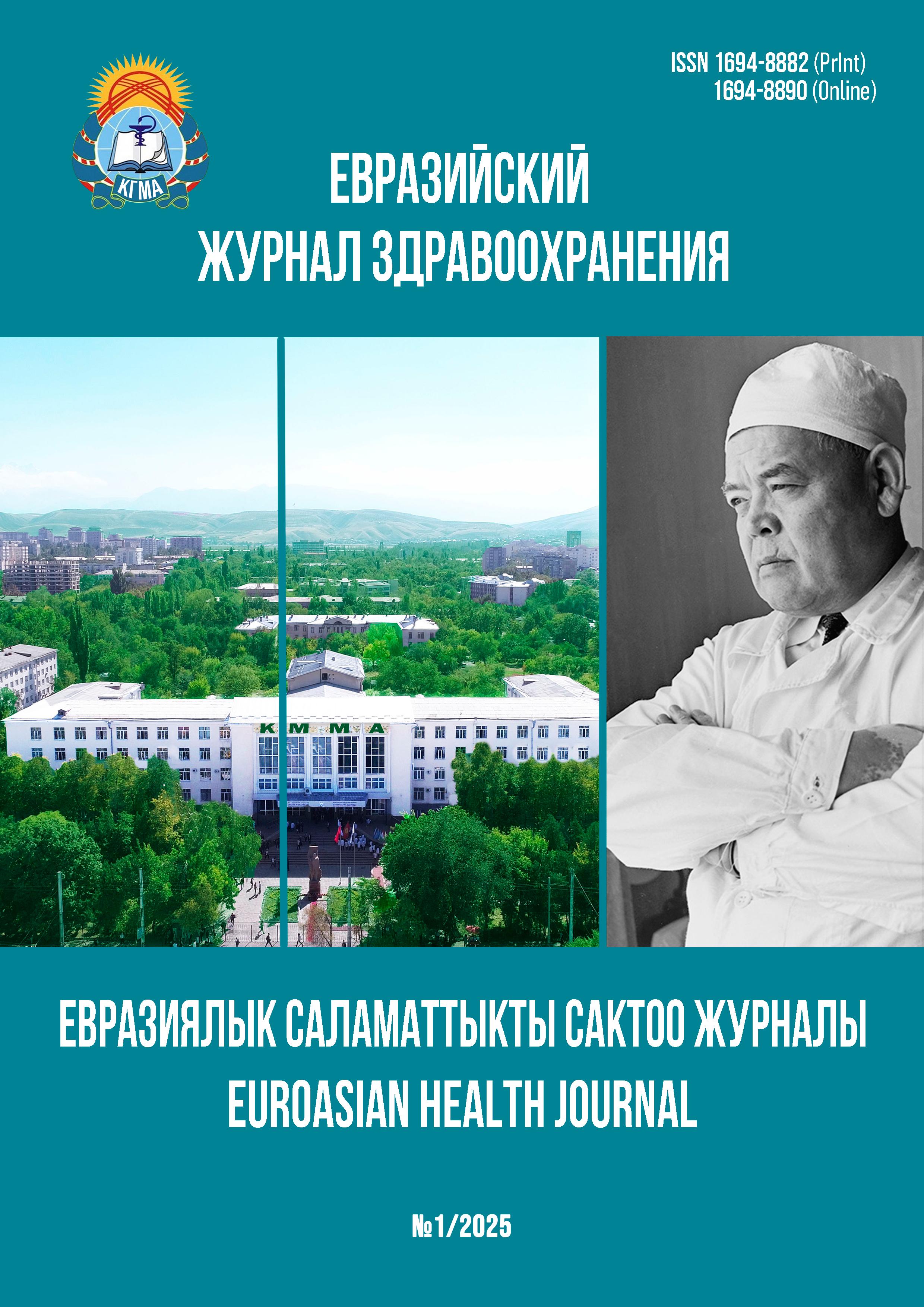GERIATRIC ISSUES OF PRESCRIBING CARDIOVASCULAR DRUGS IN THE ELDERLY
DOI:
https://doi.org/10.54890/1694-8882-2025-1-111Abstract
Cardiovascular diseases impose a significant burden on society, including in older adults, in terms of mortality, morbidity, disability, functional decline, and health care costs. In addition, due to the growing elderly population, there is a growing need to improve their health and quality of life, as well as to promote optimal medication use. Increasing age is associated with higher rates of comorbidities, disability (cognitive, intellectual, and functional impairment), and the use of multiple medications. Age-associated changes affect cardiac performance by reducing cardiac elasticity and responsiveness to pressure changes. Involutional changes lead to multiple structural and functional changes in the cardiovascular system that may increase the susceptibility of aging individuals to the development of cardiovascular diseases, which represent the most common pathological conditions in older adults. Pharmacotherapy of cardiovascular diseases in the elderly is complex because age-related changes in body composition, organ function, homeostatic mechanisms, and comorbidities alter the pharmacokinetic and pharmacodynamic properties of many commonly used cardiovascular and non-cardiovascular drugs. Due to multiple chronic diseases and age-related physiological changes that affect the pharmacodynamic and pharmacokinetic properties of drugs, it can be concluded that the prescription of pharmacotherapy in the elderly is a complex and challenging task of the geriatric approach. Polypharmacy, non-adherence, inappropriate prescription of drugs, drug interactions, and drug-related problems are common in elderly patients with cardiovascular diseases. In this regard, the risk of adverse drug reactions is higher in elderly patients. The review article is devoted to the possibilities of prescribing cardiovascular drugs in elderly people, taking into account involutional changes in the body, polypharmacy, as well as problems associated with taking medications.
Keywords:
elderly age, cardiovascular diseases, multimorbidity, pharmacotherapy, polypharmacy, fragility, patient-oriented approachReferences
1. United Nations (UN) Department of Economic and Social Affairs, Population Division. World Population Ageing 2020 Highlights: Living Arrangements of Older Persons. Available from: https://www.un.org/development/desa/pd/sites/ www.un.org.development.desa.pd/files/undesa_pd 2020_world_population_ageing_ highlights.pdf.
2. Jansen PA, Brouwers JR. Clinical pharmacology in old persons. Scientifica (Cairo). 2012;2012:723678. https://doi.org/10.6064/2012/723678
3. World Health Organization. Cardiovascular Diseases (CVDs). 2021. Available from: https://www.who.int/news-room/fact-sheets/detail/cardiovascular-diseases-(cvds) [accessed on 28 August 2022].
4. Spinewine A, Schmader K, Barber N. Hughes C, Lapane KL, Swine C, et al. Appropriate prescribing in elderly people: how well can it be measured and optimised? Lancet. 2007;370(9582):173-184. https://doi.org/10.1016/S0140-6736(07)61091-5
5. Morgan SG, Hunt J, Rioux J, Proulx J, Weymann D, Tannenbaum C. Frequency and cost of potentially inappropriate prescribing for older adults: a cross-sectional study. CMAJ Open. 2016;4(2):E346-E351. Published 2016 Jun 22. https://doi.org/10.9778/cmajo.20150131
6. Page RL 2nd, Linnebur SA, Bryant LL, Ruscin JM. Inappropriate prescribing in the hospitalized elderly patient: defining the problem, evaluation tools, and possible solutions. Clin Interv Aging. 2010;5:75-87. Published 2010 Apr 7. https://doi.org/10.2147/cia.s9564
7. Ribeiro ASF, Zerolo BE, López-Espuela F, Sánchez R, Fernandes VS. Cardiac System during the Aging Process. Aging Dis. 2023;14(4):1105-1122. https://doi.org/ 10.14336/AD.2023.0115
8. Ahmed B, Rahman AA, Lee S, Malhotra R. The Implications of Aging on Vascular Health. International Journal of Molecular Sciences. 2024;25(20):11188. https://doi.org/10.3390/ijms252011188
9. Wang M, McGraw KR, Monticone RE, Pintus G. Unraveling Elastic Fiber-Derived Signaling in Arterial Aging and Related Arterial Diseases. Biomolecules. 2025;15(2 ):153. https://doi.org/10.3390/biom15020153
10. Kobak KA, Zarzycka W and Chiao YA. Age and Sex Differences in Heart Failure with Preserved Ejection Fraction. Front. Aging. 2022; 3:811436. https://doi.org/ 10.3389/fragi.2022.811436
11. Rakisheva A, Soloveva A, Shchendrygina A, Giverts I. Heart Failure with Preserved Ejection Fraction and Frailty: From Young to Superaged Coexisting HFpEF and Frailty. Int J Heart Fail. 2024;6(3):93-106. https://doi.org/10.36628/ijhf.2023.0064.
12. Sayers J, Martinez-Navarro H., Sun X, de Villiers C, Sigal S, Weinberger M, et al. Cardiac conduction system regeneration prevents arrhythmias after myocardial infarction. Nat Cardiovasc Res. 2025;4:163-179. https://doi.org/10.1038/s44161-024-00586-x
13. Gorton AJ, Keshavamurthy S, Saha SP. Diagnosis and Management of Aortic Valvular Disease in the Elderly. Int J Angiol. 2022;31(4):232-243. https://doi.org/ 10.1055/s-0042-1759527
14. Tamargo J, Kjeldsen K, Delpón E, Semb AG, Cerbai E, Dobrev D, et al. Facing the challenge of polypharmacy when prescribing for older people with cardiovascular disease. A review by the European Society of Cardiology Working Group on Cardiovascular Pharmacotherapy. Eur Heart J Cardiovasc Pharmacother. 2022;8(4):406-419. https://doi.org/10.1093/ehjcvp/ pvac005
15. Gaur A, Carr F, Warriner D. Cardiogeriatrics: the current state of the art. Heart. 2024;110(14):933-939. https://doi.org/10.1136/heartjnl-2022-322117
16. Tian F, Chen Z, Zeng Y, Feng Q, Chen X. Prevalence of Use of Potentially Inappropriate Medications among Older Adults Worldwide: A Systematic Review and Meta-Analysis. JAMA Netw Open. 2023;6(8): e2326910. https://doi.org/10.1001 /jamanetworkopen.2023.26910
17. Drenth-van Maanen AC, Wilting Me, Jansen PAF. Prescribing medicines to older people-How to consider the impact of ageing on human organ and body functions. Br J Clin Pharmacol. 2020;86(10):1921-1930. https://doi.org/10.1111/bcp.14094
18. Scott IA, Hilmer SN, Reeve E, Potter K, Le Couteur D, Rigby D, et al. Reducing inappropriate polypharmacy: the process of deprescribing. JAMA Intern Med. 2015;175(5):827-34. https://doi.org/10.1001/jamainternmed.2015.0324
19. By the 2019 American Geriatrics Society Beers Criteria® Update Expert Panel. American Geriatrics Society 2019 Updated AGS Beers Criteria® for Potentially Inappropriate Medication Use in Older Adults. J Am Geriatr Soc. 2019;67(4):674-694. https://doi.org/10.1111/jgs.15767
20. Ngcobo NN. Influence of Ageing on the Pharmacodynamics and Pharmacokinetics of Chronically Administered Medicines in Geriatric Patients: A Review. Clin Pharmacokinet. 2025; https://doi.org/10.1007/s40262-024-01466-0
21. Salcedo-Mingoarranz ÁL, García-Díaz B, Barcia-Hernández E. Population pharmacokinetics of digoxin in elderly patients: A systematic review. Farm Hosp. 2022;46(6):359-366.
22. Sougata S, Vartika S. Prescribing optimally in the elderly: Understanding the pharmacology. Journal of Integrative Medicine and Research. 2023;1(3):81-86. https://doi.org/10.4103/jimr.jimr_9_23
23. Jeon D. Geriatric Considerations in the Management of Elderly Patients with Cardiovascular Diseases. Cardiovasc Prev Pharmacother. 2021;3(2):38-46. https://doi.org/10.36011/cpp.2021.3.e6
24. Cohen EB, Patwardhan M, Raheja R, Alpers D, Andrade RJ, Avigan M, et al. Drug-Induced Liver Injury in the Elderly: Consensus Statements and Recommendations from the IQ-DILI Initiative. Drug Saf. 2024;47(4):301–319. https://doi.org/10.1007/s40264-023-01390-5
25. Konstandi M, Johnson E. Age-related modifications in CYP-dependent drug metabolism: role of stress. Front. Endocrinol. 2023;14:1143835. https://doi.org/ 10.3389/fendo.2023.1143835
26. Handschin C, Meyer UA. Induction of drug metabolism: the role of nuclear receptors. Pharmacol Rev. 2003;55(4):649-673. https://doi.org/10.1124/pr.55.4.2
27. Naik A, Belič A, Zanger UM, Rozman D. Molecular Interactions between NAFLD and Xenobiotic Metabolism. Front Genet. 2013;4:2. https://doi.org/10.3389/ fgene.2013.00002
28. Yeh CH, Kuo TBJ, Li JY, Kuo KL, Chern CM, Yang CCH, et al. Effects of age and sex on vasomotor activity and baroreflex sensitivity during the sleep–wake cycle. Sci Rep. 2022;1:22424. https://doi.org/10.1038/s41598-022-26440-3
29. Shaulian SY, Makaryus AN, Zeltser R. Role of Vascular Receptors in the Development of Hypertension in the Elderly Population. Int J Angiol. 2022;31(4):260-266. https://doi.org/10.1055/s-0042-1759650
30. Armstrong M, Kerndt CC, Moore RA. Physiology, Baroreceptors. In: StatPearls [Internet]. Treasure Island (FL): StatPearls Publishing; 2023. Available from: https://www.ncbi.nlm.nih.gov/books/NBK538172/
31. Лузина А.В., Ткачева О.Н., Рунихина Н.К., Котовская Ю.В. Ортостатическая гипотония у пациентов пожилого возраста. Лечебное дело. 2023;2:4-12. https://doi.org/10.24412/2071-5315-2023-12875
32. Kirkwood TB. A systematic look at an old problem. Nature. 2008;451(7179):644-7. https://doi.org/10.1038/451644a
33. Rikkert M, Melis R, Cohen A, Peeters G. Why illness is more important than disease in old age. Age and Ageing. 2022;51(1):afab267. https://doi.org/10.1093/ ageing/afab267
34. Маматов С.М., Мурзаибрагимова М.М., Арстанбекова М.А., Смаилова Д.К. Профилактика сердечно-сосудистых заболеваний в пожилом возрасте (обзор литературы). Евразийский журнал здравоохранения. 2024;5:41-49. https://doi.org/10.54890/1694-8882-2024-5-41
35. Канат к. Б., Мусакеев А.О., Киндербаева Н.К., Маматов С.М., Кундашев У.К. Антикоагулянтная терапия пожилых людей во врачебной клинической деятельности центров семейной медицины Кыргызской Республики. Клиническая геронтология. 2020;26(9-10):3-8. https://doi.org/10.26347/1607-2499202009-10003-008
36. Fried LP, Tangen CM, Walston J, Newman AB, Hirsch C, Gottdiener J, et al. Frailty in older adults: evidence for a phenotype. J Gerontol A Biol Sci Med Sci. 2001;56(3):M146-M156. https://doi.org/10.1093/gerona/56.3.m146
37. Afilalo J, Lauck S, Kim D, Lefèvre T, Piazza N, Lachapelle K, et al. Frailty in Older Adults Undergoing Aortic Valve Replacement: The FRAILTY-AVR Study. J Am Coll Cardiol. 2017;70(6):689-700. https://doi.org/10.1016/j.jacc.2017.06.024
38. Сафроненко А.В., Ганцгорн Е.В., Сафроненко В.А., Кузнецов И.И., Сухорукова Н.В., Криштопа А.В. и др. Особенности фармакотерапии пациентов пожилого и старческого возраста. Южно-Российский журнал терапевтической практики. 2021;2(4):6-15. https://doi.org/10.21886/2712-8156-2021-2-4-6-15







